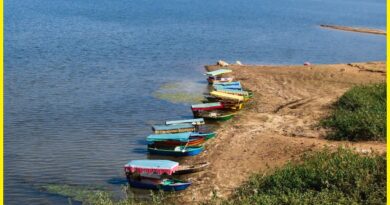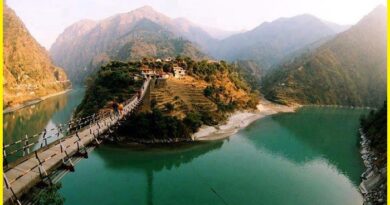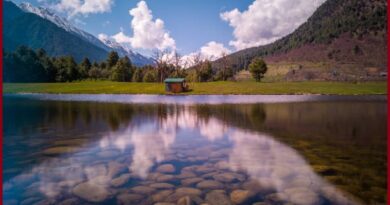Cal Orko Bolivia-A Palaeontological Wonderland Where Giants Once Walked
Cal Orko Bolivia
Cal Orko Bolivia is a significant paleontological site located in Bolivia. It is famous for its massive wall of dinosaur footprints, which provides valuable insights into the ancient history of the region. The site is situated about 5 kilometers south of the city of Sucre, the constitutional capital of Bolivia.
The name “Cal Orko” comes from the Quechua language, with “Cal” meaning lime and “Orko” meaning hill. The site itself is an exposed limestone quarry where thousands of dinosaur footprints from various species have been preserved. These footprints date back to the Cretaceous period, approximately 68 million years ago.
The vertical limestone wall, which measures around 80 meters in height and 1.5 kilometers in length, has been transformed into an open-air paleontological museum. The footprints of several dinosaur species, including theropods, sauropods, and ornithopods, can be seen here. Some footprints are up to 1.2 meters in diameter, making them some of the largest dinosaur tracks ever discovered.

Cal Orko Bolivia is not only a fascinating site for scientists and researchers but also a popular tourist attraction, drawing visitors from around the world who come to marvel at the ancient imprints left by dinosaurs long gone. It offers a unique opportunity to witness and learn about the prehistoric world and the creatures that once roamed the region.
Cal Orko Bolivia Geology
Cal Orko Bolivia is a site of great geological significance due to its unique formation and the dinosaur footprints found there. The geological features of Cal Orko are primarily related to its limestone rock formation, which is crucial in preserving the dinosaur tracks.
The site is located in the Andean region of Bolivia, near the city of Sucre. It is part of the “Sucre Formation,” a geological formation that dates back to the Cretaceous period, approximately 68 million years ago. During this time, the region was covered by a shallow sea, and sedimentary layers were deposited over millions of years. The Sucre Formation consists of various types of sedimentary rocks, including limestone. The limestone in Cal Orko Bolivia was formed from the accumulation of calcium carbonate-rich materials in the ancient shallow sea.
The unique geological aspect of Cal Orko Bolivia that makes it a dinosaur track site is the preservation of these limestone layers, which contain an extensive array of dinosaur footprints. The tracks were left behind by various dinosaur species as they walked on the soft, muddy sediment along the ancient shorelines of the Cretaceous Sea.
Over time, the layers of sediment were compacted and turned into rock, preserving the footprints in what is now a nearly vertical limestone wall. The movement of tectonic plates and the subsequent uplift of the Andes Mountains exposed this rock face, making the dinosaur tracks visible to the world.
The preservation of such a vast number of dinosaur footprints in a single location is relatively rare, making Cal Orko Bolivia an essential site for studying dinosaur behavior and paleoenvironments during the Cretaceous period. It also serves as a window into the geological history of the region and the processes that shaped the landscape over millions of years.
Also, read- Great Adventure destination Bolivia’s Altiplano; travel to explore the Geology and beautiful landscape
Cal Orko Bolivia Geological importance
The geological importance of Cal Orko in Bolivia lies in its exceptional preservation of dinosaur footprints and the insights it provides into the Earth’s history and prehistoric life. Here are some key points that highlight the geological significance of Cal Orko-
Dinosaur Footprints
Cal Orko Bolivia is renowned for its massive wall of dinosaur footprints, representing a diverse range of dinosaur species that inhabited the region during the Cretaceous period, around 68 million years ago. The site contains thousands of well-preserved tracks, offering valuable information about dinosaur behavior, locomotion, and interactions.

Paleoenvironmental Reconstruction
The presence of dinosaur footprints in the limestone rocks of Cal Orko Bolivia provides clues about the ancient environment and ecosystem. By studying the sedimentary layers and the distribution of footprints, paleontologists can infer the types of habitats that existed during the Cretaceous, such as shorelines, mudflats, or riverbeds.
Taphonomy
Cal Orko’s geological context offers an excellent opportunity to study taphonomy—the processes involved in the fossilization of remains. The preservation of the dinosaur tracks was influenced by the specific conditions of the ancient environment, such as the type of sediment, water content, and subsequent tectonic processes that led to the formation of the exposed rock face.
Geological Time Scale
The dinosaur footprints in Cal Orko Bolivia are valuable for dating the rocks and establishing the age of the geological formations. These age determinations contribute to our understanding of the geological time scale and the sequence of events that shaped the Andean region of Bolivia during the Cretaceous period.
Paleoclimatology
Studying the sedimentary layers and the ancient environment in which the dinosaur footprints were preserved can provide insights into the paleoclimate of the Cretaceous period. By analyzing the rock composition and fossilized plants and other organisms found in the vicinity, researchers can infer past climatic conditions and changes in the region.
Education and Tourism
The site’s geological importance extends beyond scientific research. Cal Orko’s well-preserved dinosaur footprints have become a significant educational and tourism attraction, promoting public interest in paleontology, geology, and natural history. It allows visitors to connect with the distant past and learn about the Earth’s geological history and the creatures that once roamed the area.
How to Reach Cal Orko Bolivia
If you are coming from outside Bolivia or from another city within Bolivia, you can take a flight to Sucre. Sucre’s Alcantarí International Airport (also known as Juana Azurduy de Padilla International Airport) receives domestic flights from major cities in Bolivia, as well as some international flights.

Once you are in Sucre, you have a few options to reach Cal Orko.
Taxi or Private Car- The most convenient way is to hire a taxi or a private car to take you directly to Cal Orko Bolivia. It’s advisable to negotiate the fare beforehand.
Public Transportation- You can take a local bus or a shared minivan (known as “micros” or “trufis” in Bolivia) that goes in the direction of the site. These modes of transport may be less comfortable than a taxi but are more budget-friendly.
Arriving at Cal Orko- The site of Cal Orko Bolivia is situated approximately 5 kilometers (3.1 miles) south of Sucre. Once you reach the area, you’ll likely find designated viewing areas or a visitor center where you can see the impressive dinosaur footprints on the vertical limestone wall.



